Types of Organization Structure | Commerce & Accountancy Optional Notes for UPSC PDF Download
Introduction
- An organizational structure delineates the various job tasks and illustrates how they are formally divided, grouped, and coordinated. It establishes an appropriate framework for authority relationships, indicating the hierarchy of authority and reporting relationships. It serves as a means to help management achieve organizational objectives.
- Given that an organization's objectives stem from its overall strategy, it is logical that the organizational structure is closely linked to its strategy. Therefore, if management makes a significant change in the organization's strategy, the structure must be adjusted to accommodate and support the change. Evidence suggests that an organization's strategy (be it a stability strategy or a growth strategy) is influenced by three key factors (contingency factors): (i) the organization's size, (ii) the technology it employs (for converting financial, human, and physical resources into products and services), and (iii) environmental uncertainty (external environment).
- Information technology and globalization have greatly impacted organizational structures. Many managers today recognize that traditional structures based on bureaucratic principles no longer suffice to address the challenges posed by the new paradigm environment. The need for flexibility, adaptability to change, creativity, innovation, knowledge, and the ability to overcome environmental uncertainties are among the most pressing challenges organizations face. Consequently, vertical (tall) structures are being replaced by horizontal (flat) structures, and organizations with mechanistic structures are evolving into organic ones.
- These shifts signify a clear move away from centralized decision-making toward decentralized, consensus-based self-control. New organizational structures have emerged, such as taskforce, network, virtual, and boundaryless structures. The following briefly describes the key features of these and other organizational structures to provide an overview of different types of organizational structures and their suitability under various situations.
Line Organisation
- The line organization represents the most straightforward form of organizational structure. It adheres to the scalar principle, which dictates that authority and responsibility should flow directly in a vertical line from the highest level of the organization to the lowest level.

- The primary focus in the line organization is on the superior-subordinate relationship, with everyone in the organization being part of the direct chain of command. One of the benefits of the line organization is that it simplifies decision-making and execution, as there is clear authority at every level of the hierarchy. However, a drawback is that if an incorrect decision is made at the top level, it is typically implemented without anyone in the lower levels daring to point out its flaws.
Line and Staff Organisation
- This type of organizational structure is commonly found in most business organizations, particularly those that are not very small. As organizations have become more complex, the challenges faced by line executives have also become increasingly intricate. Because line executives are generally generalists, they require the guidance and expertise of individuals with specialized knowledge and roles to address these issues. As a result, staff positions are established within the organization. In a line and staff organization, the line authority remains the same as it does in a line organization, meaning that authority flows from the top to the bottom, and line executives perform the primary functions, while staff functionaries support and advise the line executives. For instance, to manage human resources effectively, line managers receive specialized assistance from personnel/human resource managers. Since staff functionaries are employed to perform supportive roles, they do not possess any commanding power within the organization.
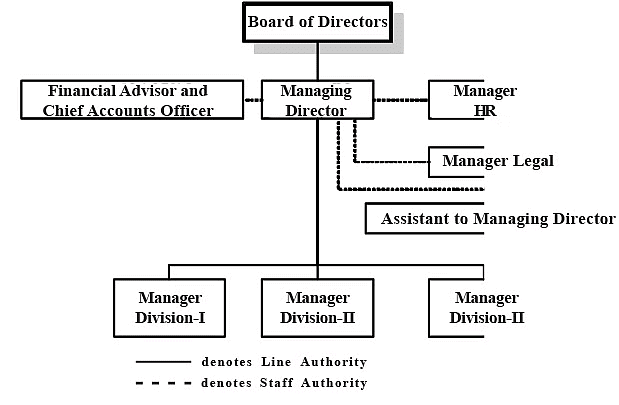
- The primary advantage of a line and staff organization is that staff specialists relieve line executives of the burden of focusing on specialized functions such as selection, training, development, wage and salary administration, accounting, public relations, and so forth. However, the drawback of this structure is that since functionaries are not held accountable for the outcomes, they may not be performing their duties effectively.
Functional Organisation Structure
- This is one of the most commonly used forms of organizational structure due to its straightforward logic and practical appeal. In this structure, tasks are grouped together based on common functions. For example, all production activities or all financial activities are grouped into a single function that carries out all the tasks related to that function. A typical chart of a functional organization is presented in Figure.
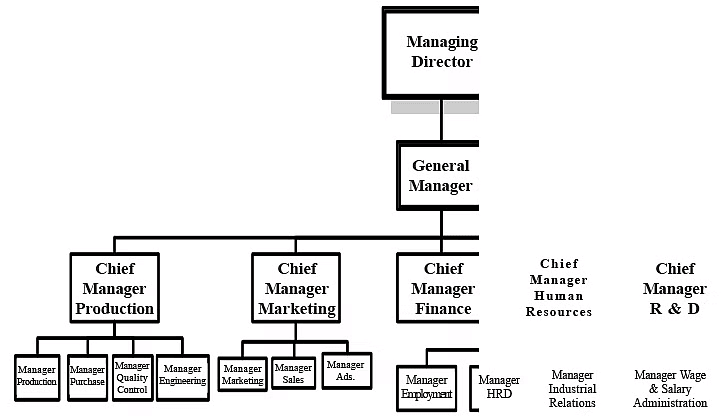
- The functional structure is best suited for small to medium-sized organizations that produce one or a few products, where the organization's goals emphasize functional specialization, efficiency, and quality. The main advantages of this type of structure are that by grouping people based on their specialized expertise, the organization can facilitate both their utilization and coordination in serving the entire organization. Functional grouping also provides opportunities for promotion and career development. One of the major disadvantages of this form of organization is the growth of sectional interests, which may conflict with the needs of the organization as a whole. For example, members of the production department may see their activities from the narrow perspective of their own department rather than from the broader perspective of the entire organization.
Product Organisation Structure/Divisional Structure
- This form of organization structure is adopted by large companies producing a wide range of products. Here, the activities are grouped on the basis of the individual products manufactured by the company. Thus, one finds autonomous “little companies within the company” adopting this type of organisation structure. As such, within each of these little independent units, we find all important functions viz. production, marketing, finance and human resources.
- The organisation structure of a large multi-product pharmaceutical company is illustrated in Figure.
- One of the advantages of the product organisation is that it enables diversification of the products to take place with minimal effort. Another advantage is that it can cope better with technological change by grouping people with expertise and their specialised equipment in one major unit. The main disadvantage of the product organisation is that each product division may promote its own product group in a way that creates problems to other product divisions of the company.
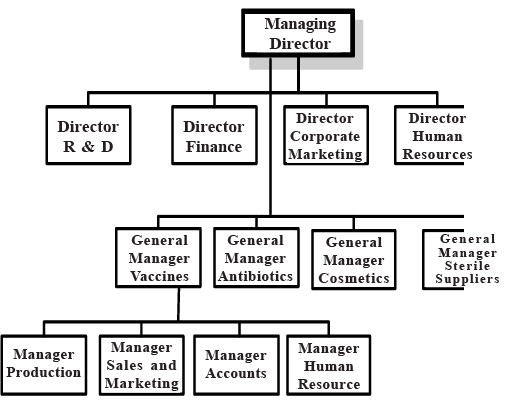
Hybrid Structure
The hybrid structure blends elements from both functional and divisional forms.
- As organizations grow larger, they often establish self-contained units. Functions considered crucial for each product are decentralized to these units, while others like finance and accounting remain centralized at headquarters for practical reasons Figure. The functional aspect of the organization is represented by the departments centralized at the corporate level. However, each product division has specialists in functional areas to provide necessary support.
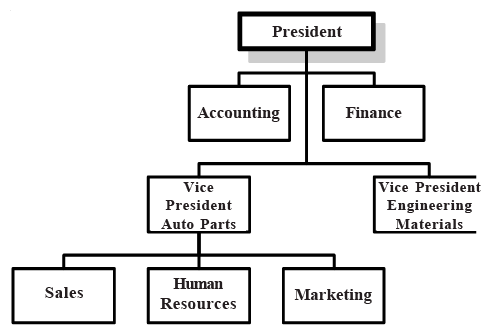
- The significant advantages of the hybrid structure include:
- The organization can leverage the benefits of both functional and product (decentralized) structures.
- It offers opportunities to enhance coordination within and among divisions.
- It enables the organization to pursue an adaptive strategy within product divisions while maintaining efficiency in functional departments.
- It ensures proper alignment of corporate and divisional goals.
- A notable disadvantage of the hybrid structure is the potential for excessive duplication of activities between functions and divisions. Additionally, it may lead to conflict between headquarters and divisional functions.
Formal and Informal Organisation
The formal organization structure refers to a framework of clearly defined jobs, each with a specific level of responsibility and authority. It establishes formal procedures, rules, and regulations that guide the conduct of individuals in these roles.
- On the other hand, the informal organization arises from the social interactions among individuals within the formal organization. When people work together, they often form informal work groups spontaneously due to factors like physical proximity or shared interests. These informal groups collectively constitute the informal organization. Unlike the formal organization, the informal one lacks structure and is not pre-defined. Typically, it emerges unofficially within a formal organization. An informal organization has its own structure, roles, procedures, norms, and values that evolve through consensus among its members. It lacks a fixed chain of command and is based on the sentiments of its members. Communication patterns are not predetermined, and communication can flow in any direction.
- In contrast to the formal organization, which is often analyzed for its functional aspects, the informal organization's dysfunctional aspects, such as conflicting objectives, output restrictions, and resistance to change, receive more attention. The informal organization is often seen as counterproductive to the formal organization.
However, it can actually benefit the formal organization in several ways:
- It serves as a valuable communication channel.
- It reduces management workload if informal workgroups are given due importance.
- It mitigates the undesirable effects of formal organization rigidity.
- It provides an outlet for employee emotions.
Centralisation and Decentralisation
- Centralisation refers to the concentration of decision-making power at a single point in the organization. In contrast, decentralisation occurs when the top management delegates significant discretion to lower-level personnel in the organization to make decisions.
- In a decentralised organisation, problems can be solved more quickly and more people can contribute to decision-making. For companies with multiple plants located in different places, decentralisation is often more beneficial. As many large companies now aim to make their organisations more flexible and responsive, there has been a notable shift towards decentralised decision-making.
The key advantages of decentralisation are:
- It reduces the burden on top management by freeing them from many operational decisions, allowing them to focus on strategic responsibilities; and
- It can enhance staff motivation by giving middle and lower-level managers a sense of responsibility and encouraging the use of knowledge, innovation, and initiative by all employees.
However, decentralisation also has its downsides:
- It requires senior management to coordinate more closely to ensure that individual units in the organisation are not working against the interests of the whole organisation;
- It can lead to inconsistency in the treatment of customers, clients, or the public, especially in service industries; and
- Decentralisation requires a sufficient supply of capable and well-motivated managers who can handle the increased responsibility it brings.
Vertical Structure
A vertical organisation is characterized by a lengthy hierarchical chain of command, meaning it has a high number of hierarchical levels. Consequently, more people must communicate to the top management through the various layers of executives Figure.
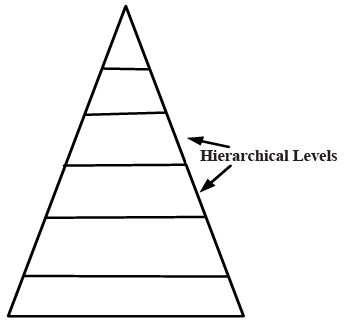
The primary advantages of vertical organisations are:
- They facilitate better communication of the organisation’s mission, values, and goals to all employees; and
- These organisations can sustain a high degree of specialisation in functions and roles.
However, vertical structures also have their drawbacks:
- Too many hierarchical levels can slow down communication and decision-making processes; and
- Vertical structures are typically associated with formality and standardisation, which can limit the scope for initiative and risk-taking at the operational levels.
Horizontal Organization
- As the traditional vertical, hierarchical structures of organizations are increasingly considered inappropriate for the changing environment, more modern organizations are turning to horizontal structures. For instance, in the US, corporate giants like AT&T, General Electric, Motorola, and Xerox, among others, have adopted principles of horizontal organizational structure.
- The horizontal structure encourages cooperation, teamwork, and customer orientation over a functional focus.
Frank Ostroff, a McKinsey & Company consultant, and his colleague Douglas Smith are credited with developing guiding principles that describe the characteristics of the horizontal structure.
- Horizontal structures are built around three to five core processes at a time rather than traditional departmental functions.
- The vertical hierarchy is flattened to reduce levels of supervision. This is achieved by consolidating fragmented tasks, eliminating non-value-adding work, and minimizing activities within each process.
- Multi-disciplinary/cross-functional self-managed teams (comprising personnel from various functional areas like finance, marketing, human resources, quality control, and operations) are formed to handle core processes, with each team assigned a core process.
- Customer satisfaction and net profits are the primary drivers and measures of performance. To this end, employees are brought into direct contact with customers and suppliers. When relevant, customers and suppliers may join as full working members of the teams responsible for core processes.
- All employees should have access to all data and should be trained to analyze and use the data to make effective decisions as team members.
- All employees are encouraged to develop multiple skills, and those who do are rewarded.
- Horizontal organizations need to foster a corporate culture of openness, cooperation, and collaboration.

Figure gives an idea about the horizontal structure of an organisation.
The main advantages of a horizontal organization are:
- Decisions can be made more quickly to solve problems; and
- A horizontal structure has fewer coordination issues.
One of the disadvantages of the horizontal structure is the lack of proper reporting by subordinates to superiors due to decentralization.
Project Organization
- When an organization takes on a significant project or multiple small projects, it establishes project organizations to complete them. This is necessary because the existing functional structure of the organization may not be suitable for completing projects that are time-bound and subject to high performance standards, such as those in aerospace and aircraft companies.
- A project organization is separate from and independent of the functional departments of the company. Led by a Project Manager, each project organization comprises a team of specialists drawn from different functional areas of the company or from outside. The size of the project team varies depending on the project, and the group size may change with different phases of the work within a project. A project organization is temporary and will be disbanded as soon as the project is completed. However, if the project's duration is long, the project organization may become a permanent autonomous project division of the company.
- The role of the Project Manager is challenging. They are responsible for completing the project on time and meeting prescribed quality standards. The successful completion of the project depends on how well the Project Manager coordinates the activities of the project team and utilizes the advice and assistance of internal experts within the company and those from external agencies or organizations.
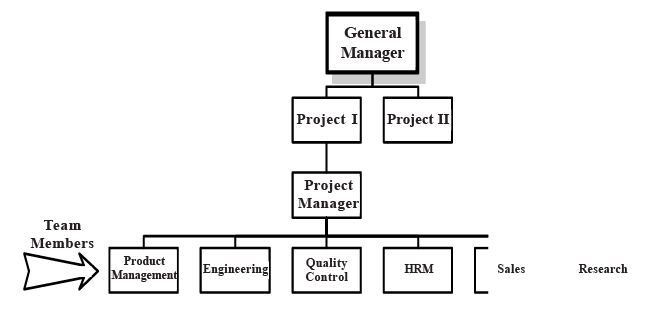
- The project organization is suitable when the company receives a one-time assignment, a significant contract, or when the company faces a unique challenge.
The main advantages of the project organization are:
- The participating specialists of the project team have the opportunity for prompt, expeditious, and effective accomplishment of the project's goals, motivating them to make maximum contributions to the project's execution;
- It facilitates speedy communication between the project manager and the team members; and 3. It provides flexibility in handling various tasks.
The major disadvantages of the project organization are:
- The entire project becomes meaningless if the project manager fails to properly coordinate the activities of the project;
- Members of the project organization may be bypassed for promotion opportunities in their respective fields because they are not part of the mainstream organizational life; and
- The job of the project manager becomes very difficult as they have to deal with specialists from a number of diverse fields.
Matrix Organization
The matrix organization is a unique structure that combines two forms of departmentalization: functional and product. It centers around a project, which is led by a Project Manager, also known as the Product Manager, as they are accountable for the project's output (product).
- Project teams consist of specialists from different functional departments like Human Resources, Finance, Production, Marketing, and Research & Development of the company. Employees in the matrix structure have two bosses: their Functional Departmental Managers (e.g., HR specialists report to the HR Department Manager) and the Project Manager. This structure deviates from the principle of unity-of-command, where no person should report to more than one boss.
- Figure illustrates the Matrix Structure of an Engineering firm, with two distinct projects, each having specific objectives and deadlines.
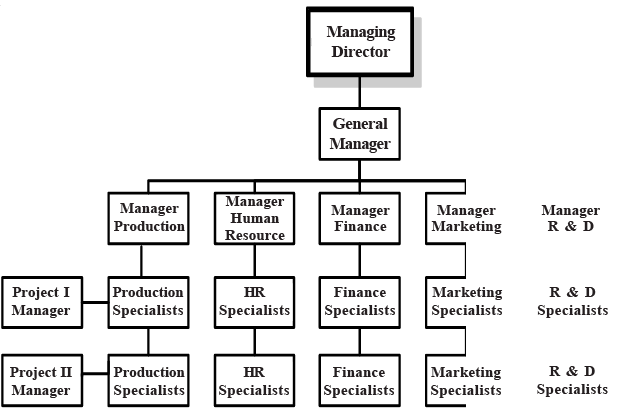
- The matrix organization differs from the functional organization in that the Project Manager in the functional organization has sole responsibility for the project and its resources. However, in the matrix organization, the Project Manager must share resources with the rest of the enterprise.
- The matrix structure is commonly used in advertising agencies, aerospace firms, R&D laboratories, construction companies, hospitals, government agencies, universities, management consulting firms, and entertainment companies.
Some of the benefits of the matrix structure include:
- It enables efficient coordination in organizations with numerous intricate and interdependent activities;
- It guarantees the efficient deployment of individuals with specialized skills; and
- It fosters direct and frequent interaction between various functional experts, resulting in improved communication and greater flexibility.
The primary drawbacks of the matrix structure are:
- It deviates from the unity of command principle, leading to role conflict and ambiguity when reporting to multiple superiors;
- It can cause power struggles between product or project managers and functional managers who share the same pool of resources; and
- A matrix organization typically incurs higher costs compared to a traditional hierarchical structure.
Virtual Organisation (Network Structure)
A virtual organization is a compact, central organization that contracts out main business functions, with minimal or no departmentalization. It collaborates with other organizations worldwide to outsource functions like production, distribution, marketing, research, and development, using electronic technology for networking. These partnerships are typically based on electronic contracts, with less permanence and formality, and are more opportunistic. Each partner contributes its core capabilities to the virtual organization. The managers of virtual organizations mainly focus on coordinating activities through networking. Examples of virtual organizations include Ford, Harley Davidson, Nike, Reebok, Mobil Corp., and IBM.
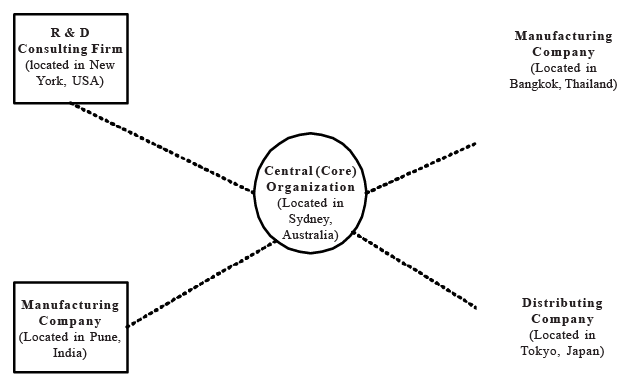
The major advantages of a virtual organization are:
- It can create a "best-of-everything" organization by leveraging each partner's core competence.
- It allows individuals with innovative ideas and limited resources to compete successfully against larger companies due to its flexible nature.
The major disadvantages of the virtual structure are:
- It reduces management's control over crucial parts of its business.
- The reliability of partners may be questionable.
Boundaryless Organization
- The term "boundaryless organization" was coined by Jack Welch, the Chairman of General Electric. This type of organization aims to eliminate both vertical and horizontal barriers within the company and to break down external barriers between the company and its customers and suppliers. When vertical barriers are removed, the organizational structure resembles a silo rather than a pyramid.
- To eliminate vertical barriers, management adopts the following strategies: i. Creating cross-hierarchical teams that include top executives, middle managers, supervisors, and operative employees; ii. Encouraging participative decision-making; and iii. Utilizing 360-degree performance appraisals, where peers and others evaluate an employee's performance.
- To break down horizontal barriers, management adopts the following strategies: i. Replacing functional departments with cross-functional teams and organizing activities around processes; ii. Using lateral transfers; and iii. Rotating employees into and out of different functional areas. External barriers can be reduced through practices like strategic alliances, customer-organization linkages, and telecommuting with networked computers.
The major advantages of a boundaryless organization are:
- It promotes teamwork among employees;
- It ensures fast communication within the organization (intra-organizational communication) and between the organization and its customers and suppliers (inter-organizational communication); and
- It can enhance competitiveness in the global economy.
One significant drawback of this organizational form is that it can be challenging to establish clear relationships between superiors and subordinates.
Inverted Pyramid
Organisations with this type of structure put the customers at the top and give them the most important role in driving the business. The front-line employees like sales representatives, people in charge of help-desk, etc. who come in direct contact with the customers, are also given a similar position. The Chief Executive Officer of the organisation is at the bottom of the structure (Figure 11). Thus, in this form of organisation, the role of the management changes from a commanding one to a supporting one.
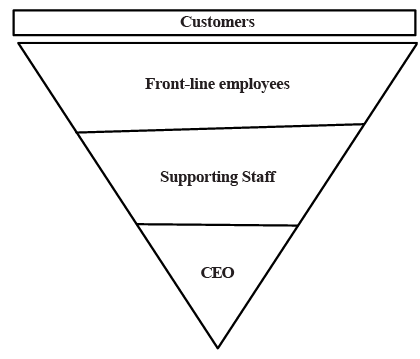
Some of the advantages of the inverted pyramid are:
- This structure gives first preference to the customers. Therefore, it becomes easy for the organisation to know the customers’ choices, and to work out appropriate strategies to ensure customers’ satisfaction; and
- In this form of organisation, the employees are given more responsibility and authority than the top management.
A major disadvantage of the inverted pyramid relates to formulation of strategies. The frontline foremen are not quite equipped to formulate strategies regarding the organisation. This leaves sufficient ground within the organisation to doubt about their capabilities to make appropriate strategies.
Task Force
- A task force is a temporary assembly of specialists from different functional departments, created to tackle a specific and intricate task. It operates alongside the conventional structure, resembling a reduced version of the temporary matrix. Once a task force completes its mission, its members are often assigned to another task force.
- Ford Motor successfully implemented the task force structure in the U.S. in the early 1980s. One advantage of the task force is that an organization can simultaneously benefit from both the traditional structure and the task force. These advantages include stability, flexibility, and efficiency.
- However, a major disadvantage arises if management fails to coordinate the task force's activities or maintain harmonious interpersonal relationships within it, undermining the purpose of creating the task force.
Mechanistic and Organic Structure
- Mechanistic and organic structures were identified by Tom Burns and G.M. Stalker in a landmark study of 20 British firms during the 1960s. They found that mechanistic organizations were characterized by rules, procedures, a clear hierarchy of authority, centralized decision-making, and controlled communication from the top down, with information often shared on a need-to-know basis. In contrast, organic organizations had low formalization, with written rules and regulations often ignored, and open communication patterns involving horizontal, diagonal, and vertical channels.
- Burns and Stalker's research emphasized that organizations could adapt their structures to their environments. In rapidly changing environments, organizations tend to adopt an organic form to remain competitive, while the mechanistic form is preferred in more stable environments.
- Stephen P. Robbins suggests that these structures represent two extremes of a continuum. While the mechanistic model is often associated with bureaucracy, the organic model resembles a boundaryless organization. The relationship between the two is flexible, and an organization may shift between them depending on factors such as the environment, overall strategy, size, and technology.
|
196 videos|219 docs
|
FAQs on Types of Organization Structure - Commerce & Accountancy Optional Notes for UPSC
| 1. What is the difference between line organisation and line and staff organisation? |  |
| 2. How does a functional organisation structure differ from a product organisation structure? |  |
| 3. What is a hybrid structure in an organisation? |  |
| 4. What is the significance of formal and informal organisation in a company? |  |
| 5. How do centralisation and decentralisation impact decision-making in an organisation? |  |





















